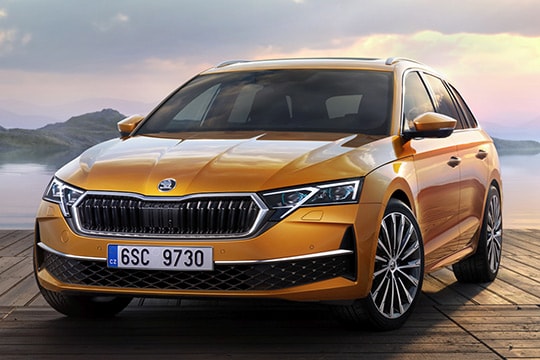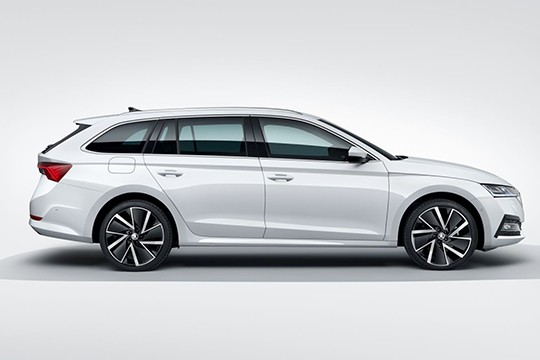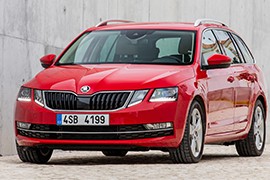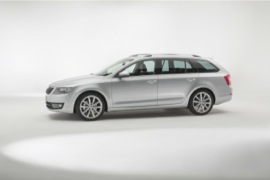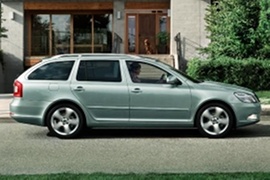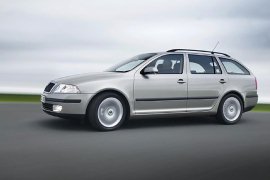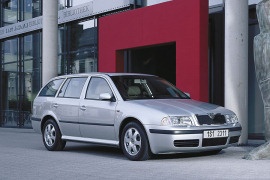SKODA Octavia Combi Models/Series Timeline, Specifications & Photos
First production year: 1997
Engines: Gasoline, Mild hybrid, Diesel, Hybrid, Natural gas
Body style: Wagon (station wagon, estate, combi, touring)
Skoda facelifted the fourth generation of the Octavia in 2024, almost five years after the model’s introduction in late 2019, and besides the hatchback, it also updated the station wagon version, traditionally named the Combi in the automaker’s inventory.
In late 2019, Skoda launched the fourth generation of the Octavia. Unfortunately for the Czech automaker, the world pandemic started a few months later, and it had to shut down the assembly lines. Everyone went home and waited for better days. As a result, it wasn’t until the summer of 2020 that the car reached the dealers and customers could get it. Usually, Skoda used to upgrade its vehicles once every four years, so it postponed the update for Octavia’s fourth generation until early 2024. The new version was slightly longer, had an updated look, and featured better technologies.
At the front, the 2024 Octavia Combi sported new, second-generation MatrixLED headlights, which were available as an option. The black grille between them featured two sets of six vertical double slats that flanked the radar needed for the adaptive cruise control. Depending on the grade, the car could be equipped with LED fog lamps, which were also available for the lower trim levels.
From its profile, the long-roof version of the Octavia sported a new wheel design, with sizes ranging between 16- and 19-inch. The front of the car, up to the B-pillars, was similar to the hatchback, or Sedan as Skoda named it. At the same time, the rear doors were different, while the roof extended over the trunk space and ended with a spoiler that created a sporty look for the vehicle. At the back, the raked-forward tailgate sported part of the newly designed LED taillights, which stretched from the quarter panels. The rear bumper had a slightly different design, featured a small diffuser in the middle, and concealed the car’s exhaust.
Inside, customers were greeted by a new dashboard. The driver fronted a ten-inch digital display mounted inside the instrument cluster. They could also enjoy the new 13-inch touchscreen of the infotainment unit that stood atop the center stack. Skoda introduced a new system based on ChatGPT to provide customers with a better driving experience. The split-folding (4/2/4) bench seat in the back could accommodate up to three passengers on short trips. Behind them, the car retained the 640-liter (22.6 cu-ft) trunk with the rear seats up, which was the largest in the segment. Moreover, by folding down the rear bench seat, customers could expand the loading area up to 1,700 liters (60 cu-ft.).
Under the hood, Skoda installed a wide choice of engines ranging between 115 PS (113 hp) and 265 PS (260 hp), either gasoline or diesel. All versions were turbocharged, and some of them were available with mild-hybrid technology. The car was available with a front- or an all-wheel drive system. Depending on the version, customers could get the 2024 Octavia with a six-speed manual or a seven-speed automatic (dual-clutch) gearbox.
The Czech automaker Skoda introduced the fourth sequel of its most successful model, Octavia, in 2019, and like the previous generations, it offered it with a choice of two bodyworks: a hatchback and a station wagon.
Skoda used the same MQB base as the Volkswagen Golf, Audi A3, and Seat Leon when it made the fourth generation of the Octavia. Still, the vehicle’s shape and the wheelbase were adjusted according to the automaker’s needs. But, unlike its siblings, Skoda insisted on keeping some of its clever solutions, such as the integrated umbrella in the driver’s door or the ice-scraper attached inside the fuel flap.
The Czech automaker followed the same cubist design language specific to the brand. As a result, the fourth generation of the Octavia Combi featured angular headlights with L-shaped daytime running lights inside them. Depending on the trims and options, there were three LED groups inside each headlamp. The main grille, placed above the bumper, featured a hexagonal shape and was surrounded by a chromed rim and a set of vertical dark slats for all grades. On the lower bumper, the automaker added a narrower air intake where customers could get the LED fog lamps that were standard or optional, depending on the engine or trim level. The Combi version featured a similar shape as its hatchback sibling up until the rear doors but featured an extended roof stretched to the end of the vehicle and ended with a raked-forward tailgate adorned by a roof spoiler on its top. Finally, the sharp LED taillights were split at the back between the quarter panels and the large tailgate.
Skoda offered the Octavia with a wide range of options for the interior. While the base model featured cloth seats and basic instrumentation, the upper trim levels boasted Alcantara upholstery, aluminum pedals, and a floating-style touchscreen for the infotainment system atop the center stack. Furthermore, customers could get the car with a complete digital instrument cluster and, as a first for the Octavia, a head-up display. The front occupants could benefit from the heated and ventilated seats, which were on the options list, along with the heated steering wheel. In the back, the split-folding (60/40) bench seat could accommodate comfortably two passengers, but with enough room for a middle-seated one. The 640-liter (22.6 cu-ft) trunk with the rear seats up was the largest in the segment. Moreover, by folding down the rear bench seat, customers could expand the loading area up to 1,700 liters (60 cu-ft.).
Under the hood, the fourth generation of the Octavia came fitted with a wide choice of engines ranging between 110 PS (108 hp) and 204 PS (201 hp) with front or all-wheel-drive systems. A six-speed manual gearbox was standard on lower spec versions, while the upper levels got a seven-speed automatic (dual-clutch) transmission.
Skoda unveiled a facelifted version for the Octavia station wagon in 2017 and introduced a new signature front fascia for one of its best-selling products.
Since the Euro6d-Temp emission standards became mandatory for Europe and it was also one of the most important markets for the Czech carmaker, the Octavia had to be adjusted accordingly. But Skoda brought more improvements, not just a new engine lineup and a new set of light-alloy wheels on the options list.
One of the most controversial parts of the car was its front, where Octavia featured a split headlight design. Some considered that it resembled those installed on the Mercedes-Benz E-Class from the same period, but Skoda claimed it followed the cubist-design style. A wide grille with black vertical slats filled the space between them and featured a small dent on its top for the badge. The extended roofline and the optional tinted rear side windows were part of the Combi (station wagon) package, and so were its new LED taillights with smoked lenses.
Inside, The Czech carmaker introduced a new infotainment system, which allowed the driver to remotely check the windows or the fuel level from a smartphone. The 2017 Octavia Combi also featured improved active and passive safety systems, such as traffic sign recognition or City Emergency Brake, including Pedestrian Protection. The trunk area was extensive, offering 610 liters (21.5 cu-ft), which could have been expanded to up to 1,740 liters (61.4 cu-ft) by completely folding down the rear seats.
Under the hood, Skoda replaced the former 1.2-liter gasoline units with an even smaller, 1.0-liter turbocharged engine and kept the 150 hp 1.4-liter turbocharged unit. For turbo-diesel versions, it offered just two instead of five as the non-facelifted version.
The Octavia is Skoda's biggest-selling model worldwide, , and in 2013 the Czech carmaker, with the third iteration of the model, pushed success even further. First, we want to mention one of the most essential things: size.
Size matters, doesn’t it? The new Skoda Octavia Combi makes a mark in its segment in every possible way. It offers space found only in higher classes and is wider and longer than its previous version. There is no other car in the compact segment that offers more interior length (1,782 mm), more knee room (73 mm), and more headroom at the back (980 mm). And that is not all. The third generation of Skoda Octavia has a 610-liter boot space, 30 liters more than Octavia 2, earning some points in practicality.
On the outside, it comes with roof rails fitted as standard. Every line and joint shows Skoda's attention to detail. The front-end's details were accentuated by emphasizing the horizontal lines yet keeping the unmistakably Octavia look and carrying it into a new era.
The new Skoda logo is now placed on the hood, making the slightly bigger radiator grille look more opulent. The headlights were redesigned too, now emphasizing sharpness along with the radiator grille. Compared to the previous model, the side of the new Skoda Octavia is clearly sportier and more dynamic.
Everything is in its proper place, arranged well, and cleanly styled. The dashboard controls are logically laid, and the dials are easy to read. The interior was designed to offer generous space and aesthetic appeal.
Among the new technological options, the new Octavia Combi can be equipped with Adaptive Cruise Assistant, Automatic Parking Assistant, traffic-sign recognition, KESSY (Keyless-Entry-Start-and-Exit-System), and better infotainment system with touch displays and CANTON sound system, which was optimized for the passenger space.
In terms of comfort, the Octavia stays in its class, is decently comfortable, and has four different driving selections, including the Individual, where you can set it up depending on your needs.
Due to its extra bulk, the 2.0 liter TDI version is the best, especially if you intend to tow a trailer or a caravan. Or if you want to feel some more sportiness, you can go for the 2.0 petrol engine. Both versions give good driving quality thanks to the DSG automatic gearbox.
Having said all this, if you are one of those people always looking for the price tag and want plenty of space for your hobbies like scuba diving, climbing, surfing, mountain biking, or even to carry smaller stuff for your DIY business, the Skoda Octavia Combi might be something good to give a try. Regarding fuel consumption, the vehicle is one of the most economical cars in its class.
In conclusion, even if we talk about a family car or a car capable of fulfilling your space needs, this third-generation of Skoda Octavia is worth its money.
Skoda introduced a facelift for the Octavia's second generation in 2008 and kept the sales figures on top of the compact-segment charts.
While the automotive industry was on the brink of a collapse due to the world financial crisis, Skoda introduced the facelifted version for the Octavia. It was its best selling products, and the carmaker was ready to be hit by a big drop in sales. But the marketing department said that a facelift could smoothen the drop and the engineering team speed-up the facelift introduction.
There was a new front fascia for the Octavia. It featured bigger, swept-back headlights and a broader grille with chromed surroundings. The front bumper was modified as well and showed a wider grille at the bottom and two side-pods for the newly designed foglights.
Inside, Skoda increased the material's quality and introduced a new infotainment system on the center stack. The interior was roomy, with plenty of room for five adults and one of the biggest trunks in the compact-segment. With all the seats up it provided 605 (21.4 cu-ft) liters of trunk space, which could have been extended up to 1655 liters (58.4 cu-ft).
Under the hood, Skoda installed a wide range of engines, similar to the ones offered on the sedan version. For selected versions, a 7-speed automatic (dual-clutch) gearbox was available at extra cost.
Skoda introduced the second generation of the Octavia at the 2004 Geneva Motor Show in both body versions, hatchback and station wagon, continuing its predecessor's success story.
When Volkswagen decided to buy the Czech brand Skoda, it tried to make it as a mass-market brand, affordable and reliable as a Golf. The first generation of the Octavia was highly successful and sold globally. The second generation followed the same recipe, using the Golf's platform (PQ35), and offered the vehicle a wide choice of engines and options.
From the outside, the second generation was very similar-looking to its predecessor. The overall design adopted a few cubist details with straight lines and narrow edges, such as the headlights and the sloped-down, corner-mounted turn-signals. A chromed rim surrounded its squared grille with vertical slats. Depending on the options and trim level, the Octavia Combi featured a pair of fog-lights on the lower side of the bumper. From its sides, the long greenhouse extended over the trunk area with a slightly curved roofline made room for the third row of windows installed over the rear quarter panels. Like on its predecessor, the carmaker installed the taillights outside the tailgate area, while the rear window featured a third brake light at the top.
The clean, clear design with slightly curved surfaces and straight gray trims made the car look more in the mid-price segment than on the budget-cars. It was somewhat more expensive than its predecessor, but the materials used were of better quality. The Octavia II Combi featured a 580 liters (20.5 cu-ft) trunk size that could be expanded up to a staggering, for its class, 1620 liters (67.8 cu-ft) by completely folding down the rear bench.
The Octavia I was the first car that brought the Skoda carmaker under the spotlight after being purchased by Volkswagen Group.
Skoda had a good name in the Eastern European market, and it was also appreciated in other Western countries as well. But it was famous for being well-built, not well-engineered. With the Octavia I, everything changed. It was built on the same platform as the Golf, which brought many benefits in terms of engineering and technical solutions. As for the build quality, it was known for being a very dependable vehicle.
Its design was different than anything else produced by the German carmaker. It was designed in the cubist style, with clear lines and angles all over the place. Its rectangular headlights and the slightly taller grille surrounded by a chromed trim were a bold statement for the Czech carmaker. From its profile, the long-roof construction made room for a third side window behind the rear doors, while the tailgate was curved down, trying to fit customers' preferences.
Inside, Skoda installed a pair of bucket seats at the front covered in fabric. Later on, a special version named Laurin&Klement received leather upholstery and better amenities. It offered enough room for three adult passengers in the back, even though the car was crossed by a center tunnel from front to rear. In addition, the split-folding (60/40) rear bench allowed it to get one of the most spacious trunks on the market, with a total volume of over 1,500 (53 cu. ft.).
Under the hood, the carmaker installed VW-sourced powerplants, either gasoline or turbo-diesel. Depending on the version, the Octavia I Combi also got an automatic transmission. Later on, the carmaker added all-wheel drive versions as well.
